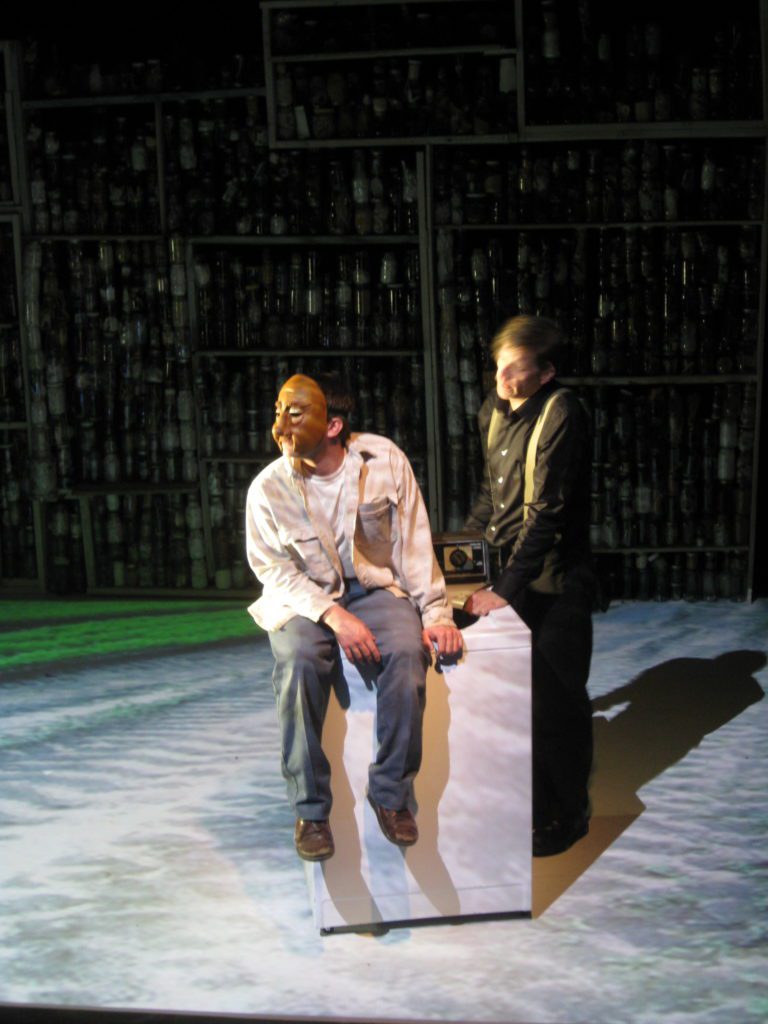Every now and then, the Buntport troupe decides to remind audiences that they’re not just clever, funny, creative and entertaining; they’re also artists. And that’s just what they do with Indiana, Indiana, a production based on a novel by Laird Hunt of the University of Denver. The story isn’t complicated. An old man, Noah, who’s always been a little touched, remembers his life and obsesses over his brief, lost marriage to Opal. Scenes from his life – his childhood, his short stint as a mailman, his interactions with his parents – are acted out in a surreal way; periodically, someone called Max reads him letters from Opal, most of them communicating a kind of febrile ecstasy. It turns out that Opal, too, had mental problems, and was committed to a mental institution by (I think) Noah’s father, Virgil. Virgil may also have ended Noah’s visitation rights, so there’s longstanding and unresolved pain between father and son.
The piece is imagistic and poetic rather than literal. With their usual deft and imaginative stagecraft, the Buntporters have filled the evening with fluidly surprising moments. One thing transforms into another, windows and doors appear where once there were none, furniture slides on and off the stage, and mood and meaning are created by the interplay of different media: music, human voices and bodies, still and moving images, concrete objects that shimmer with an undefinable significance. At one point, an actor begins playing the saw. No sooner has the creaky note sounded than it starts to rise and purify, and we realize we’re hearing the haunting sound of a woman’s voice. For weeks, Buntport’s Facebook page sported a request for Mason jars; filled with a variety of things that denote the thoughts and events of Noah’s life – corks, dried leaves, yarn, used tea bags, buttons, seed pods, sticks, bones – these homely objects become a shimmering wall that dominates the set.
The visual metaphors are so luminous and beautiful that I hate to admit that sometimes I don’t quite see why they’re there, or what they have to do with the theme or storyline – a storyline that isn’t, in itself, particularly riveting. Take the man playing the saw. This is a moment of pure visceral pleasure, and interesting thoughts follow about the melding of the mechanical and the human, the artist’s ability to make something ethereal out of something mundane – just as the company does with its canning jars. It’s all very lovely and touching in an abstract sort of way, but what does the saw man have to do with Noah? There’s another, equally inventive moment that works gloriously, however: the joining together of Noah and Opal, done with swaying lights in a way I won’t describe because you just have to see it for yourself.
As actors, the Buntporters have taken a risk with Indiana, Indiana. They’ve set aside their usual hilarious antics and are playing it straight and vulnerable – an approach that reveals just how accomplished they’ve become. Taking on characters that range from the town sheriff to the genial Max (Noah’s son, perhaps?) to a coughing minister (Is he sick? Why doesn’t the script tell us?), Brian Colonna works with quiet assurance and is as good as I’ve ever seen him. Hannah Duggan is nurturing as Noah’s mother and purely touching as Opal. Playing Noah, Evan Weissman dons a mask early on, a weird, puff-cheeked thing, above which the dark line of his hair looks like a cap. He takes it off only once, when Noah and Opal come together, but manages to communicate all of Noah’s passions and regrets from behind this ambiguous mask. And while I never quite figured out what had caused the rift between Noah and his father, Erik Edborg’s profound sorrow as he walked slowly across the stage stilled all my questioning.
Buntport’s low-tech, high-creativity approach has had us seething with laughter often enough. This time, it’s the force behind an evening of quietly hypnotic beauty.
-Juliet Wittman, September 16, 2009, Westword
